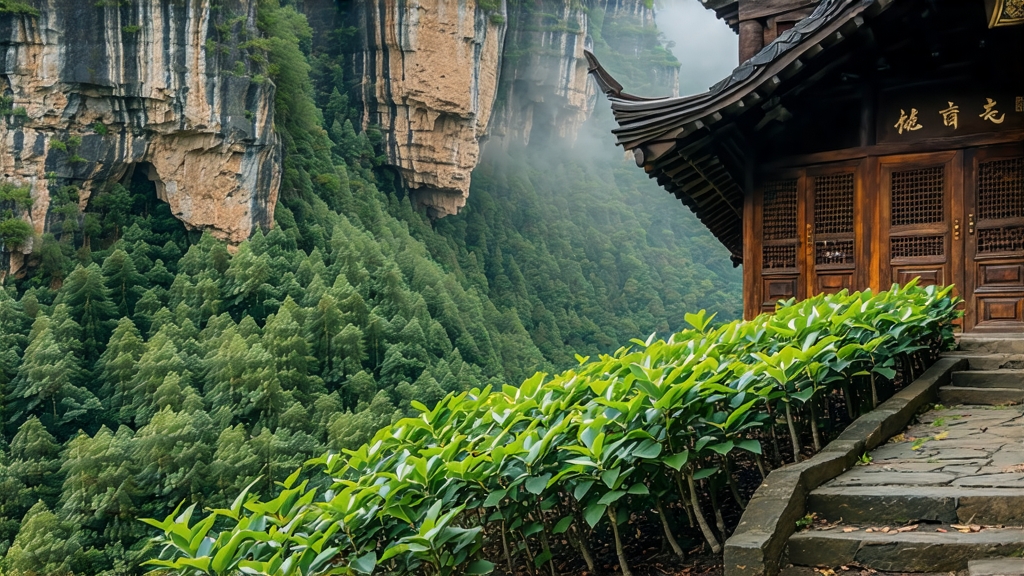
If green tea is the fresh-faced youth of Chinese tea and pu-erh the venerable elder, then Wuyi Shui Xian occupies the intriguing middle ground: mature, complex, and quietly confident. Among the hundreds of oolong styles scattered across Fujian, Guangdong, and Taiwan, Shui Xian from the Wuyi Mountains remains the benchmark for “rock oolong” (yancha), a sub-category whose very name promises a sip of stone. International drinkers often meet Tie Guan Yin first, yet once they encounter Shui Xian’s layered orchid aroma, charcoal warmth, and lingering mineral finish, many confess that everything before felt like a prelude.
A 2000-year-old corridor of sheer cliffs, winding streams, and Danxia landforms, the Wuyi range has sheltered tea since the Song dynasty. Local monasteries kept grafted gardens on narrow ledges; Song-era poets already praised “rock flowers” perfuming mountain air. The cultivar now called Shui Xian—literally “water sprite” or “narcissus”—arrived much later, around the 1850s, when a Qing merchant transplanted hardy bushes from nearby Jianyang county onto Wuyi’s mineral-rich shelves. The bushes thrived, absorbing the same quartz and feldspar that give the cliffs their purple-red hue. Within decades Shui Xian eclipsed older Wuyi varieties in both acreage and fame, yet it never became a mass-market commodity; the treacherous terrain limits each garden to a few thousand square metres, ensuring every batch remains a negotiation between human persistence and geological grandeur.
Although the term “Shui Xian” can legally appear on any oolong made from the cultivar, connoisseurs reserve the name Wuyi Shui Xian for leaf grown inside the 60-km² core scenic zone known as Zhengyan, “true cliff.” Here the microclimate performs daily alchemy: morning fog traps humidity, afternoon sun filters through narrow gorges, and cool evening air slows oxidation, letting aromatics concentrate. Outside Zhengyan lie the Ban Yan (“half cliff”) and Zhou Cha (“river terrace”) belts, still picturesque but lacking the intense rock essence, or yanyun, that defines the inner sanctum. Thus a single cultivar gives birth to a quality staircase: Zhengyan Shui Xian commands prices rivalling Burgundy grand crus, while river-terrace versions offer an affordable introduction to the yancha genre.
Crafting Shui Xian is a month-long relay of timing, muscle memory, and fire management. Picking begins in late April when the third leaf opens to the size of a sparrow’s tongue; only three leaves and a bud are plucked, ensuring both fragrance and body. The first marathon is wilting: trays of leaves are shaken, tossed, and sun-dried in repeated cycles that bruise the edges while keeping the centre intact. This partial oxidation—usually 30–40 %—unlocks the cultivar’s signature orchid note, yet stops short of the darker 60 % seen in Tie Guan Yin. After the enzymatic “green stripe” appears, leaves are quickly pan-fired at 220 °C to halt oxidation, then rolled into the familiar dark strips using a bamboo drum that looks like an ancient printing press.
What truly separates Wuyi Shui Xian from other oolongs is its charcoal baking stage. Traditionally the rolled leaves spend 6–12 hours on shallow rattan trays stacked above a pit of glowing lychee-wood embers. Temperature hovers between 80 °C and 120 °C; any hotter and the leaf sugars carbonise, any cooler and moisture remains, inviting mold. Master bakers “read” the fire by ear—listening for the soft pop of escaping steam—and rotate trays every twenty minutes. Some premium lots endure three separate bakes over three months, each round followed by a month of “rest” so that residual heat redistributes. The result is a liquor the colour of antique amber, its bouquet marrying toasted cacao, narcissus blossom, and the unmistakable scent of hot stones after rain.
To brew Shui Xian respectfully one must borrow the Gongfu mind-set: small vessels, many short infusions, and an almost meditative attention to change. A 100-ml gaiwan or Yixing zisha teapot is ideal; zisha’s porous clay absorbs roasted notes and later rewards